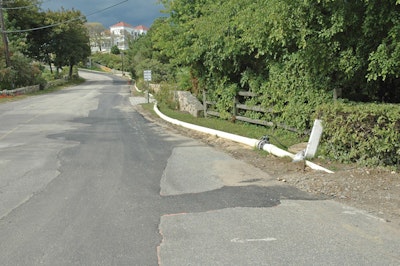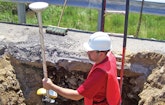
Interested in Rehab/Relining?
Get Rehab/Relining articles, news and videos right in your inbox! Sign up now.
Rehab/Relining + Get AlertsBenjamin Franklin once said, “When the well runs dry, you know the worth of water.” The residents of Cohasset, Mass., couldn’t agree more. The taps ran dry in part of this affluent South Shore Boston suburb of 7,000 people on Memorial Day weekend, 1994.
“One whole section of town simply ran out of water,” says Glenn Pratt, former chairman of the Cohasset Board of Water Commissioners. “People turned on their faucets and there was nothing. It caused political upheaval, as you might imagine. This is New England, where we have open town meetings, and everyone has their say. A couple of our commissioners resigned.”
The crisis also launched Cohasset on a 15-year, $33 million project to upgrade a water treatment and distribution system that had been allowed to deteriorate for years. Today, the system, operated under contract with American Water, is as good as they get. Though water rates are the highest in the state, residents don’t seem to mind. When they turn on the kitchen faucet, the garden hose, or the lawn irrigation system, they get plenty of good, clean water.
Letting it slide
The Cohasset Water Department operates as an enterprise fund, owned by the town and governed by elected commissioners. The department supplies drinking water to 2,400 residents and to a neighboring retirement community. It also provides and maintains waterlines for firefighting. The system is funded entirely through water bill revenue, and rates are approved at the annual town meeting.
About 40 years ago, realizing that its water system would not be adequate for future needs, the town built a new water treatment plant at Lily Pond and created the Aaron River Reservoir to supply water for a population expected to grow to 20,000 in the decades ahead.
“When those projects were completed, community leaders assumed the problems had been resolved,” says Pratt. Not so, of course. Increased demand for water, brought on by such luxuries as inground watering systems, started straining capacity in parts of the community. Sediment built up in the Bear Hill storage tank. Old lines deteriorated. Water leaks became common. At the same time, the department faced labor turmoil and annual budget deficits.
“From 1977 to 1994, not a nickel was spent on maintenance or improvements,” Pratt recalls. “Little was done except an occasional repair when something broke.”
Spurred to action
When the system failed on that holiday weekend, Cohasset got serious about its water supply. Over the next couple of years, the commission put together a comprehensive long-range plan and began to make the necessary improvements. Initially, the town focused on installing new water mains, repairing old mains in its 36-mile system, and adding reserve capacity to ensure adequate pressure and supply to fight fires.
By the end of the 1990s, the town had installed new water meters at each customer site, made improvements to the water supply filter beds to reduce sediment in the system, and launched an extensive program to clean and inspect all water mains. Operational squabbles came to an end when the town signed a plant operations contract with American Water (the agreement has just been renewed for another 10 years).
A second water storage tank, larger and taller than the old tank, was built on Scituate Hill, allowing the town to take the old Bear Hill tank down for repairs and cleaning. More than seven feet of sediment was removed from the tank bottom.
In recent years, fire hydrants have been repaired and repainted, and 100 more hydrants are now in service around the system. The old well field was rebuilt, and Cohasset began selling water to the neighboring retirement community of Linden Pond. A new 1.5-mile line provides an average of 325,000 gallons of potable water a day through a booster station that lifts the flow 20 feet and includes monitoring for pH, chlorine, fluoride, turbidity and color.
Cohasset has also taken steps to protect critical watershed areas, improve the Lily Pond treatment facility, and build rain gardens and other low-impact structures to control stormwater runoff. “It took 15 years of non-stop construction,” says Pratt.
Fixing the mains
More than half the town’s water mains were either repaired or replaced during the Cohasset project, according to Tom Keeffe of Tutela Engineering Associates of Wilmington, Mass., which had the major design responsibility for the distribution system. The department had installed several miles of new water main along a two-lane state highway in the 1950s — that was still in good shape.
Open-trench construction was used for most of the new lines, while test pits at bends and valves about every 800 feet provided access for cleaning and lining of existing pipes. “Some of these lines consisted of cast-iron pipes that dated back to the 1800s,” Keeffe says. In many cases, the C-factor (friction level) in the pipes had increased to the point where flow or pressure, or both, were inadequate. In fact, the town was in danger of losing its fire insurance rating. “In some places, flow was down to 20 gallons a minute or less,” says Keeffe.
To restore or increase the capacity of the line, larger-diameter class 52 cement-lined ductile iron replacement pipe was either pulled through the existing excavations or laid right alongside the old lines to increase capacity. Existing excavations were used in a rocky section along the coastline, where opening new trenches would have been difficult if not impossible. Contractors Tom Gioioso Construction of Rockland and R. M. Pacella of Plainville headed the pipe replacement projects.
Pipe lining
Depending on the length of the line, it sometimes proved cost-effective to salvage existing lines by cleaning and lining them. Bizko Contracting Corp. of Fall River pulled chain flails through the lines to clean the interior surfaces and then used sprayer assemblies that traveled through the pipes and lined them with concrete. CCTV units provided final inspection of the cleaning and lining.
The rehabilitation of the distribution system continued over the full tenure of the project. The initial work provided a new two-mile loop to the section of the town that ran out of water back in 1994. Once service had been restored to those customers, contractors concentrated on the worst sections first, based on flow restriction and pipe ages.
“Priorities were based on benefits achieved,” Keeffe says. “The town contracted for about $750,000 to $1 million dollars a year. We wanted local contractors to bid as opposed to one large contract. And in the Northeast, we are limited to the warmer seasons.”
In the Little Harbor section of the community, installation of new water mains was coordinated with new sewer lines being installed by the town wastewater utility, saving on excavation and pavement resurfacing costs. In addition to the replacement and lining, contractors undertook spot repairs around the system where needed.
During construction, surface bypass lines were frequently used to supply water to affected customers. Pratt says that while these temporary lines maintained water service, the flow was free to customers and was not metered, so 60 to 90 days of usage data was lost.
Leaks and losses
Leaks presented other problems. The town reports that 417 individual system leaks were identified and fixed during the project, saving more than 75 million gallons of water and more than $100,000 a year. Using acoustical testing, the town located many of the leaks in old goosenecks or galvanized connections at service connections, which normally occur about every 100 feet throughout the system.
A technician hired by American Water continues acoustic testing of the system on a regular basis. In addition to the distribution lines, the Cohasset rehabilitation project reworked the old well field and added storage capacity to the system.
The Ellms Meadow well field dates to the 1880s when the community drew most of its supply from seven shallow wells. It was kept in operation to supplement flow from the reservoir during dry summer months. Keeffe’s firm designed a plan to keep the well field active by replacing the old wells with five new wells, each driven to 25 feet, and by constructing a pumping station where chlorine and fluoride are added to the flow and measured using Hach instrumentation.
The new storage tank on Scituate Hill gives the town a total storage capacity of 1.8 million gallons. It is a welded steel vessel 75 feet in diameter and 58 feet tall. Internal Tideflex Technologies (Red Valve) duckbill diffusers completely mix the tank contents to keep the water fresh.
Keys to success
After so many projects over so many years, Cohasset could write the manual on how to rehabilitate an entire system. Pratt says careful division of responsibilities, and coordination across all tasks was extremely important. Also, Cohasset was able to secure funding from a variety of sources to help pay the millions of dollars in bills.
Instead of lumping all projects into a single contract with one consulting firm, Cohasset divided the work among three companies. “This way, they were able to really focus on each phase of the project,” explains Pratt.
Tutela Engineering Associates designed and planned the distribution system work. The improvements at the treatment plant were the responsibility of Weston & Sampson Engineers of Peabody, and Norfolk Ram Group of Plymouth developed the watershed protection plans.
The fact that all three firms were working on the Cohasset project at the same time made coordination critical, and hiring a construction project manager was another key step. “Normally, the water system employs six people, but during the project, we staffed up to 12, including the construction manager, who was responsible for coordinating all phases of the project,” says Pratt. “He served as a good traffic cop.
“We added an extra clerk position in the office, hired three more people to work on the distribution system, and added an extra operator at the plant because we were running more unscheduled shifts.”
Financial help
Cohasset also looked for funding wherever it could. The town tapped into the Massachusetts state revolving loan fund for $21 million. The agreement to sell water to the Linden Pond development nearby was another revenue source. The town received additional money through a grant from the state Department of Environmental Protection and got funds from the Clean Water revolving loan fund to support the construction of 36 rain gardens. The balance of the money was raised through public bond issues and rate increases. Today, 62 percent of the water system’s annual budget goes to debt retirement.
“It’s the biggest public works construction project the town has ever undertaken,” says Pratt. “Pretty aggressive for a small town.” The board was just as aggressive on the public relations front, reporting progress regularly in the local news media. Bill stuffers alerted customers to pending projects and changes. A first-rate color brochure details the history of the project and the benefits to the community.
The board refused to sidestep customer complaints. “If we knocked down someone’s fence, we just went ahead and paid for it,” says Pratt. “It wasn’t worth it to argue over claims.”
Happy ending
Pratt, who runs a local building maintenance company and is finishing his twelfth year on the Water Board, sits back and expresses satisfaction with the progress his town has made.
“We finished all of the projected improvements, and we have a great system — one of the best in the state,” he says. “We spent $33 million, but we’re in terrific shape. Sixty percent of our distribution is less than 10 years old. We’re producing excellent water. We’ve maxed out our scores on the insurance bureau ratings. It’s a good place to be.”










